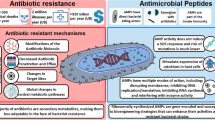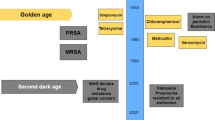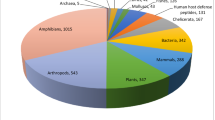Abstract
Antimicrobial peptides (AMPs) are ancient immune effectors and are considered as new anti-infective drugs. AMPs differ from conventional antibiotics in their pharmacodynamics, speed of killing and they do not increase mutagenesis. This results in a much lower probability of bacterial resistance evolution against AMPs. AMPs are usually expressed as synergistic cocktails. If AMPs are to be used in the clinic to tackle the antibiotic crisis, understanding their natural biology will be pivotal to prevent resistance.
Article PDF
Similar content being viewed by others
Avoid common mistakes on your manuscript.
Literatur
Zasloff M (2002) Antimicrobial peptides of multicellular organisms. Nature 415: 389–395
Liu Y, Wang Y, Walsh T et al. (2016) Emergence of plasmid-mediated colistin resistance mechanism MCR-1 in animals and human beings in China: a microbiological and molecular biological study. Lancet Infect Dis 16: 161–168
Rodríguez-Rojas A, Makarova O, Rolff J (2014) Antimicrobials, stress and mutagenesis. PLoS Pathog 10: e1004445
Yu G, Baeder D, Regoes R, Rolff J (2018) Predicting drug resistance evolution: insights from antimicrobial peptides and antibiotics. Proc Roy Soc Lond B 285: 20172687
El Shazely B, Yu G, Johnston P, Rolff J (2020) Resistance evolution against antimicrobial peptides in Staphylococcus aureus alters pharmacodynamics beyond the MIC. Front Microbiol 11: 103
Makarova O, Rodriguez-Rojas A, Eravci M et al. (2016) Antimicrobial defence and persistent infection in insects revisited. Phil Trans R Soc B 371: 20150296
Yu G, Baeder D, Regoes R, Rolff J (2016) Combination effects of antimicrobial peptides. Antimicrob Agents Chemother 60: 1717–1724
Tekin E, White D, Kang T et al. (2018) Prevalence and patterns of higher-order drug interactions in Escherichia coli. Syst Biol Appl 4: 31
Baeder D, Yu G, N. Hozé et al. (2016) Antimicrobial combinations: bliss independence and Loewe additivity derived from mechanistic multi-hit models. Phil Trans R Soc B 371: 20150294
Lazzaro B, Zasloff M, Rolff J (2020) Antimicrobial peptides: application informed by evolution. Science 368: eaau5480
Kintses B, Jangir P, Fekete G et al. (2019) Chemical-genetic profiling reveals cross-resistance and collateral sensitivity between antimicrobial peptides. Nat Comm 10: 5731
El Shazely B, Urbański A, Johnston P, Rolff J (2019) In vivo exposure of insect AMP resistant Staphylococcus aureus to an insect immune system. Insect Biochem Mol Biol 110: 60–68
Funding
Funding note: Open Access funding enabled and organized by Projekt DEAL.
Author information
Authors and Affiliations
Corresponding author
Additional information
Danksagung
Wir danken allen Mitgliedern der AG Evolutionsbiologie und unseren Ko-Autoren und Ko-Autorinnen, die an den vorgestellten Arbeiten beteiligt waren, sowie Klaus Reinhardt für Feedback. Wir danken der DFG für die Förderung (SFB 973, FOR 5026).
Alexandro Rodríguez-Rojas Biologiestudium. 2001–2003 Forscher in F&E am Carlos J. Finnlay Impfstoffinstitut, Havanna, Kuba. 2004–2005 Forschungspraktikum, Hospital Univesitario la Paz, Madrid, Spanien. 2006–2010 Promotion an der Universität Complutense Madrid. 2010–2012 Postdoc am Spanischen Nationalen Zentrum für Biotechnologie, Madrid. 2012–2021 Senior Postdoc an der FU Berlin bei Prof. Dr. J. Rolff. Seit 2022 Forschungsgruppenleiter an der Veterinärmedizinischen Universität Wien.
Jens Rolff Biologiestudium. 1996–1999 Promotion an der TU Braunschweig bei Prof. Dr. G. Rueppell. 1999 Postdoc am Imperial College London, UK, bei Prof. Dr. H. C. J. Godfray. 2000–2003 Postdoc und Marie-Curie Fellow an der University of Sheffield, UK, bei Prof. Dr. M. Siva-Jothy. 2003–2012 NERC Research Fellow, Lecturer und Senior Lecturer, University of Sheffield. Seit 2012 Professor für Evolutionsbiologie an der FU Berlin.
Rights and permissions
Open Access: Dieser Artikel wird unter der Creative Commons Namensnennung 4.0 International Lizenz veröffentlicht, welche die Nutzung, Vervielfältigung, Bearbeitung, Verbreitung und Wiedergabe in jeglichem Medium und Format erlaubt, sofern Sie den/die ursprünglichen Autor(en) und die Quelle ordnungsgemäß nennen, einen Link zur Creative Commons Lizenz beifügen und angeben, ob Änderungen vorgenommen wurden. Die in diesem Artikel enthaltenen Bilder und sonstiges Drittmaterial unterliegen ebenfalls der genannten Creative Commons Lizenz, sofern sich aus der Abbildungslegende nichts anderes ergibt. Sofern das betreffende Material nicht unter der genannten Creative Commons Lizenz steht und die betreffende Handlung nicht nach gesetzlichen Vorschriften erlaubt ist, ist für die oben aufgeführten Weiterverwendungen des Materials die Einwilligung des jeweiligen Rechteinhabers einzuholen. Weitere Details zur Lizenz entnehmen Sie bitte der Lizenzinformation auf http://creativecommons.org/licenses/by/4.0/deed.de.
About this article
Cite this article
Rodríguez-Rojas, A., Rolff, J. Antimikrobielle Peptide – Inspiration aus der Natur. Biospektrum 28, 135–137 (2022). https://doi.org/10.1007/s12268-022-1728-3
Published:
Issue Date:
DOI: https://doi.org/10.1007/s12268-022-1728-3




